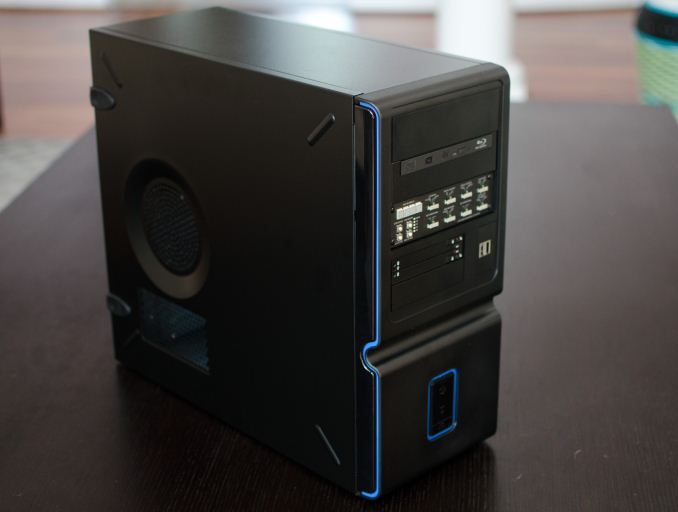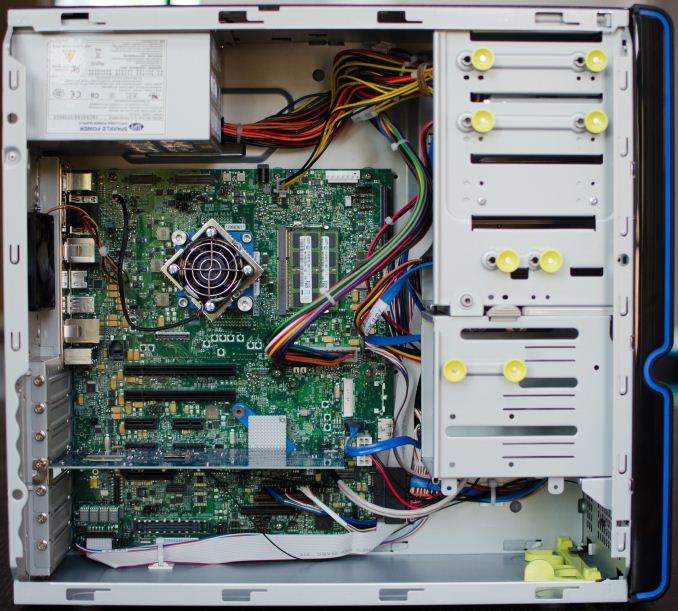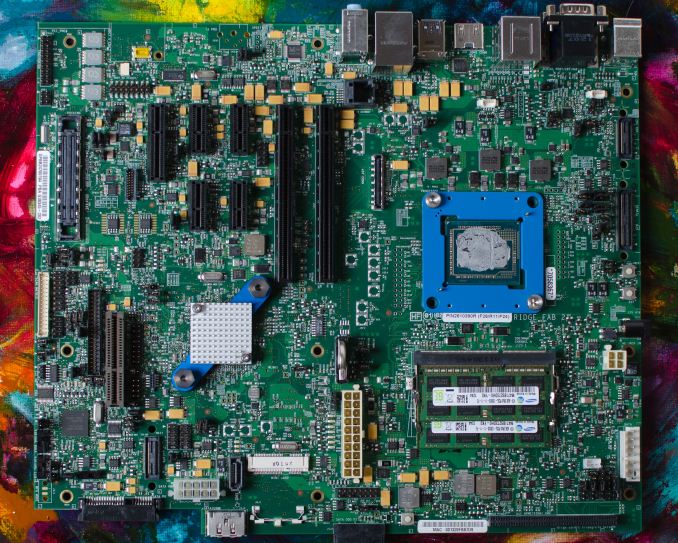Intel Iris Pro 5200 Graphics Review: Core i7-4950HQ Tested
by Anand Lal Shimpi on June 1, 2013 10:01 AM ESTThe Core i7-4950HQ Mobile CRB
At a high level, Iris Pro 5200 would seem to solve both problems that plagued Intel graphics in the past: a lack of GPU hardware and a lack of memory bandwidth. As a mostly mobile-focused design, and one whose launch partner isn’t keen on giving out early samples, it seemed almost impossible to evaluate Iris Pro in time for the Haswell launch. That was until a week ago when this showed up:
What may look like a funny mid-tower from a few years ago is actually home to one of Intel’s mobile Customer Reference Boards (CRB). Although the chassis is desktop-sized, everything inside is optimized for mobile. It’s just easier to build things larger, especially when it comes to testing and diagnosing problems.
The silicon on-board is a 47W Core i7-4950HQ, the lowest end launch SKU with Iris Pro 5200 graphics. The chassis is obviously overkill for a 47W part, but the performance we get with this machine should be representative of any i7-4950HQ system with a cooler capable of dissipating 47W.
If you read our Haswell CPU review you’ll know that Intel tried to be stingy with telling us die sizes and transistor counts for the bulk of the Haswell lineup, electing to only give us data on dual-core Haswell GT3 and quad-core Haswell GT2. Knowing that mobile parts ship without integrated heat spreaders, I went to work on pulling off the i7-4950HQ’s heatsink (after I finished testing, just in case).
With the heatsink off and thermal paste wiped off, I used my bargain basement calipers to get a rough idea of die area. This is what I came up with:
| Intel Haswell | |||||||||||||||||
| CPU Configuration | GPU Configuration | Die Size | Transistor Count | ||||||||||||||
| Haswell GT3e (QC) | Quad-Core | GT3e | 264mm2 + 84mm2 | ? | |||||||||||||
| Haswell GT2 (QC) | Quad-Core | GT2 | 177mm2 | 1.4B | |||||||||||||
| Haswell ULT GT3 | Dual-Core | GT3 | 181mm2 | 1.3B | |||||||||||||
The Crystalwell die measures 7mm x 12mm (84mm^2), while the quad-core Haswell + GT3 die is a whopping 264mm^2 (16.2mm x 16.3mm). Working backwards from the official data Intel provided (177mm^2 for quad-core GT2), I came up with an 87mm^2 adder for the extra hardware in Haswell GT3 vs. GT2. Doubling that 87mm^2 we get a rough idea of how big the full 40 EU Haswell GPU might be: 174mm^2. If my math is right, this means that in a quad-core Haswell GT3 die, around 65% of the die area is GPU. This is contrary to the ~33% in a quad-core Haswell GT2. I suspect a dual-core + GT3 design is at least half GPU.














177 Comments
View All Comments
kyuu - Saturday, June 1, 2013 - link
It's probably habit coming from eluding censoring.maba - Saturday, June 1, 2013 - link
To be fair, there is only one data point (GFXBenchmark 2.7 T-Rex HD - 4X MSAA) where the 47W cTDP configuration is more than 40% slower than the tested GT 650M (rMBP15 90W).Actually we have the following [min, max, avg, median] for 47W (55W):
games: 61%, 106%, 78%, 75% (62%, 112%, 82%, 76%)
synth.: 55%, 122%, 95%, 94% (59%, 131%, 102%, 100%)
compute: 85%, 514%, 205%, 153% (86%, 522%, 210%, 159%)
overall: 55%, 514%, 101%, 85% (59%, 522%, 106%, 92%)
So typically around 75% for games with a considerably lower TDP - not that bad.
I do not know whether Intel claimed equal or better performance given a specific TDP or not. With the given 47W (55W) compared to a 650M it would indeed be a false claim.
But my point is, that with at least ~60% performance and typically ~75% it is admittedly much closer than you stated.
whyso - Saturday, June 1, 2013 - link
Note your average 650m is clocked lower than the 650m reviewed here.lmcd - Saturday, June 1, 2013 - link
If I recall correctly, the rMBP 650m was clocked as high as or slightly higher than the 660m (which was really confusing at the time).JarredWalton - Sunday, June 2, 2013 - link
Correct. GT 650M by default is usually 835MHz + Boost, with 4GHz RAM. The GTX 660M is 875MHz + Boost with 4GHz RAM. So the rMBP15 is a best-case for GT 650M. However, it's not usually a ton faster than the regular GT 650M -- benchmarks for the UX51VZ are available here:http://www.anandtech.com/bench/Product/814
tipoo - Sunday, June 2, 2013 - link
I think any extra power just went to the rMBP scaling operations.DickGumshoe - Sunday, June 2, 2013 - link
Do you know if the scaling algorithms are handled by the CPU or the GPU on the rMBP?The big thing I am wondering is that if Apple releases a higher-end model with the MQ CPU's, would the HD 4600 be enough to eliminate the UI lag currently present on the rMBP's HD 4000?
If it's done on the GPU, then having the HQ CPU's might actually get *better* UI performance than the MQ CPU's for the rMPB.
lmcd - Sunday, June 2, 2013 - link
No, because these benchmarks would change the default resolution, which as I understand is something the panel would compensate for?Wait, aren't these typically done while the laptop screen is off and an external display is used?
whyso - Sunday, June 2, 2013 - link
You got this wrong. 650m is 735/1000 + boost to 850/1000. 660m is 835/1250 boost to 950/1250.jasonelmore - Sunday, June 2, 2013 - link
worst mistake intel made was that demo with DIRT when it was side by side with a 650m laptop. That set people's expectations. and it falls short in the reviews and people are dogging it. If they would have just kept quite people would be praising them up and down right now.